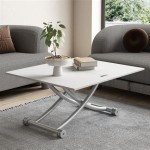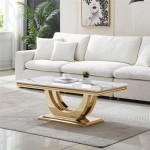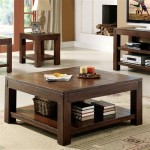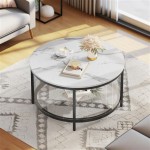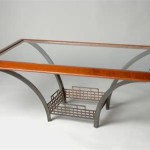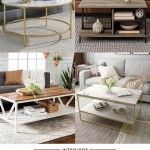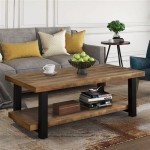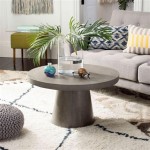Coffee Table and Two Side Tables: A Cohesive Living Room Ensemble
Selecting furniture for a living room involves considering not only individual pieces but also their interplay. A well-chosen coffee table, partnered with two strategically placed side tables, can elevate the functionality and aesthetic appeal of a living space. This article explores the importance of this furniture grouping, delving into considerations for style, material, size, and arrangement to optimize a living room's design and utility.
Furniture selection directly impacts the comfort and practicality of a room. The coffee table acts as a central anchor, providing a surface for beverages, books, and decorative items. Side tables, positioned beside seating, offer convenient surfaces for lamps, remote controls, and personal belongings. When selected cohesively, these three pieces contribute to a unified and functional living area.
Achieving Aesthetic Harmony: Style and Design Considerations
The visual appeal of a living room is significantly influenced by the stylistic cohesion of its furniture. Choosing a coffee table and side tables that share design elements creates a unified and deliberate look. This does not necessarily mean purchasing a matching set, but rather selecting pieces that complement each other in terms of style, color, and materials.
For example, a modern living room might benefit from a coffee table with clean lines and a minimalist design, paired with side tables featuring similar characteristics. In contrast, a traditional living room could incorporate a coffee table with ornate detailing and side tables that echo this design with carved legs or intricate hardware. The key is to establish a visual connection between the pieces.
Consider the overall aesthetic of the room when making selections. Color palettes should work in harmony, and materials should complement each other. For instance, a coffee table with a glass top and metal frame could be paired with side tables featuring similar materials or complementary colors in their construction. The goal is to create a sense of balance and visual flow within the space.
Furthermore, paying attention to shapes and forms can enhance the overall design. A round coffee table can soften the angularity of a room, while square or rectangular tables provide a sense of structure. Similarly, the shape of the side tables should complement both the coffee table and the seating arrangement. Experimenting with different combinations can help determine the most visually appealing arrangement for a particular space.
Ultimately, the aesthetic harmony of the coffee table and side tables should contribute to the overall design vision for the living room. By carefully considering style, color, materials, and shapes, it is possible to create a cohesive and visually appealing space that reflects personal taste and preferences.
Optimizing Functionality: Size and Placement Strategies
Beyond aesthetics, the functionality of a coffee table and side tables is paramount. Selecting the correct size and strategically placing these pieces can significantly improve the usability of the living room. Consideration should be given to the size of the room, the arrangement of the seating, and the intended uses of the tables.
The height of the coffee table is crucial for comfortable use. Ideally, it should be approximately the same height as the seat cushions of the sofa or slightly lower. This allows for easy access to beverages, snacks, and other items placed on the table. A coffee table that is too high can be awkward and uncomfortable to use.
The length and width of the coffee table should also be proportionate to the size of the sofa. A general rule of thumb is that the coffee table should be about two-thirds the length of the sofa. This ensures that there is enough space around the table for movement and access to seating.
Side tables should be positioned within easy reach of seating, typically beside or at the end of sofas and chairs. The height of the side tables should be similar to the armrests of the seating to provide a convenient surface for lamps, books, and drinks. Placing side tables strategically ensures that essential items are readily accessible to occupants of the room.
Consider the intended uses of the side tables when determining their size and placement. If the side tables are primarily intended for holding lamps, a smaller surface area may suffice. However, if they are also intended for holding books, magazines, or other items, a larger surface area may be necessary. The placement of electrical outlets should also be considered when positioning side tables, particularly if they are intended for use with lamps or electronic devices.
In smaller living rooms, space-saving solutions may be necessary. Nesting side tables can be a practical option, allowing for additional surface area when needed without taking up permanent floor space. Similarly, coffee tables with built-in storage can provide a convenient place to store blankets, pillows, or other items.
By carefully considering the size and placement of the coffee table and side tables, it is possible to optimize the functionality of the living room and create a comfortable and convenient space for relaxation and entertainment.
Material Choices and Durability: Ensuring Long-Term Value
The materials used in the construction of a coffee table and side tables significantly impact their durability, appearance, and overall value. Different materials offer varying levels of resistance to wear and tear, require different levels of maintenance, and contribute to different aesthetic styles. Selecting materials that are appropriate for the intended use and the overall design of the living room is essential.
Wood is a classic and versatile material choice for coffee tables and side tables. It offers a warm and inviting aesthetic and can be finished in a variety of colors and styles. Hardwoods, such as oak, maple, and cherry, are particularly durable and resistant to scratches and dents. Softwoods, such as pine and cedar, are less expensive but may be more susceptible to damage. When selecting wood furniture, it is important to consider the type of wood, the quality of the finish, and the overall construction of the piece.
Metal is another popular material choice for coffee tables and side tables, particularly in modern and industrial-style living rooms. Metal frames can provide a sleek and minimalist aesthetic, and they are generally very durable and easy to maintain. Stainless steel, wrought iron, and aluminum are common metal choices for furniture. When selecting metal furniture, it is important to consider the type of metal, the finish, and the quality of the welding or construction.
Glass is often used as a tabletop material for coffee tables and side tables. It provides a clean and modern aesthetic and can make a room feel more spacious. Tempered glass is a strong and durable option that is less likely to shatter than regular glass. When selecting glass furniture, it is important to consider the thickness of the glass, the type of edging, and the quality of the frame or legs.
Other materials, such as stone, concrete, and acrylic, are also sometimes used in the construction of coffee tables and side tables. Stone and concrete can provide a unique and rustic aesthetic, while acrylic can be used to create interesting and contemporary designs. When selecting furniture made from these materials, it is important to consider their weight, durability, and maintenance requirements.
The durability of the materials should be considered in relation to the intended use of the coffee table and side tables. In a household with young children or pets, it may be wise to choose materials that are resistant to scratches, stains, and spills. Similarly, in a high-traffic area, it may be best to choose materials that are easy to clean and maintain.
By carefully considering the materials used in the construction of a coffee table and side tables, it is possible to ensure that these pieces will provide long-term value and contribute to the overall aesthetic of the living room.

Ashley Roybeck Coffee Table 2 End Tables Homemakers

Vecelo 3 Piece Occasional Table Set With Coffee 2 End Tables Brown Com

2090 Espresso Wood Coffee Table With 2 Side Tables Mysleep Furniture

Holaki Glass Coffee Table And End Sets Of 3 For Living Room Tea 2 Side Tables Black Metal Leg Rectangle Tempered Com

Havalance Coffee Table 2 End Tables Marlo Furniture

Set Of 1 Henrietta Gold And Clear Glass Coffee Table 2 Side Tables Nicholas John Interiors

Set Of 2 Side Tables Coffee Nesting Gold Frame Marble End Table

Furniturehmd Set Of 2 Side Tables With Storage For Living Room Pre Assembled Round Occasional Coffee Nesting End Diy At B Q

Contemporary Wooden Center Coffee Table With 2 Side Tables Set Of 3 Furniture Buy For Every Home Sunrise International

Faux Marble End Table 2 Tier Round Sofa Bedside With Shelves Tables Small White
